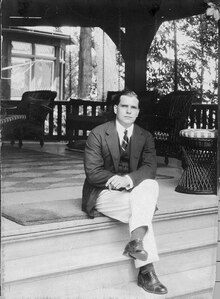Career
Early years
While at Yale, Case became interested in telephonic currents that derived from modulating light. In 1916, he opened Case Research Lab in Auburn, where he studied materials that could be altered by light. His studies led to the development of the Thalofide (thallium sulfide) cell, a light-sensitive vacuum tube from 1916 to 1918. The Thalofide cell was originally used by the United States Navy in a top secret infrared signaling system developed at the Case Lab.
Work in sound-on-film
Case began working on his sound-on-film process in 1921. The inventions of the Case Research Lab from 1916 to 1926 were the creation of Case and Earl I. Sponable, who worked with Case at the lab until he went with Case to Fox Film Corporation in 1926. The ship-to-ship signaling system was first tested in 1917 off the shores of New Jersey. Attending the test was Thomas Edison, contracted by the Navy to evaluate new technologies. A complete success, the signaling system was used by the Navy for a number of years. He worked with other people, including Lee De Forest, to create a sound-on-film process similar to modern analog sound film systems.
Titles filmed by Case in his process, all made at the Case Studios in Auburn, New York, include Miss Manila Martin and Her Pet Squirrel (1921), Gus Visser and His Singing Duck (1925), Bird in a Cage (1923), Gallagher and Shean (1925), Madame Fifi (1925), and Chinese Variety Performer with a Ukulele (1925). Gus Visser and His Singing Duck was nominated to the National Film Registry in 2002.
There were hundreds more test films made at the Case Lab that were lost in a fire in the 1950s. The Case Research Lab has become a public museum. Adjacent to the lab is the estate's carriage house where sound-film tests were made on its second floor. That sound studio is also open to the public and its collections include a seven-foot square balsawood box, known as a "blimp," that housed the camera and operator during filming. The original amplifiers and many more items used in the development of sound film at the Case Research Lab are also on display, as well as an early Wall camera used by Movietone News.
Case and DeForest
From 1921 to 1924, Case provided Lee De Forest, inventor of the audion tube, many inventions from his lab that made DeForest's Phonofilm sound-on-film process workable, though DeForest had been granted general patents in 1919. To develop a light for exposing a soundtrack to film, the Case Lab converted an old silent-film projector into a recording device. With it, the AEO light was created, which was mass-produced for use in all Movietone News cameras from 1928 to 1939, and in recording sound in all Fox feature films from 1928-1931. Movietone News used a single-system to record the sound and image simultaneously in a camera, while feature film production moved to a system that recorded sound on a separate machine that was essentially a sound camera with the lenses and picture shutter missing. It was an optical tape recorder that used film rather than tape and was mechanically interlocked with the picture camera.
On April 15, 1923, DeForest presented eighteen short films made in the Phonofilm process at the Rivoli Theater in New York City. The printed program for this presentation gives credit to the "DeForest-Case Patents". However, shortly after DeForest filed a lawsuit in June 1923 against Freeman Harrison Owens, another inventor who had worked with DeForest on sound-on-film systems, Case and DeForest had a falling-out.
The dispute between Case and DeForest was due to Case not being properly credited for his lab's contributions to Phonofilms. Case attended the April 1923 presentation of Phonofilm and was never mentioned during that presentation. By this time, DeForest had already been repeatedly warned by Case to present the truth of the inventions, to no avail. The films shown at the Phonofilm presentation used the Case Research Lab AEO Light for recording sound, were filmed with a camera designed by the Case Lab, and used the Case Lab's Thallofide Cell for reproducing the sound. In September 1925, Case stopped providing DeForest with his lab's inventions, effectively putting DeForest out of the sound film business, but not out of the "claiming to have invented sound film" business.
The Case Research Lab then set about to perfect the system of sound film they had provided DeForest, now that DeForest was no longer able to inhibit their development of this new technology. One of the first things Case did was to change the location of the sound head on a sound-film projector from being above the picture head (as had been the Phonofilm standard) to below the picture head. According to Sponable, [irrelevant citation] there were three reasons for this change: to accommodate a large flywheel in the soundhead, to simplify the design of the printer (which printed the picture and soundtrack in two separate passes) and to prevent films made to the Phonofilm standard being played on Case equipment. Case chose a separation of 20 frames between the sound and the picture frame to which it relates, this standard was adopted by all subsequent sound-on-film systems.
Case, Elwell and John Logie Baird
In June 1924, renowned Scottish inventor and television pioneer John Logie Baird bought from Cyril Frank Elwell a thallium sulfide (Thalofide) cell, developed by Case. The Thalofide cell was part of the important new technology of 'talking pictures', i.e. Phonofilm.
Movietone and William Fox
On July 23, 1926, William Fox of Fox Film Corporation bought Case's patents relating to the sound-on-film process and formed the Fox-Case Corporation. From 1926 to 1927, Case worked with Fox's technicians to develop the Fox Movietone process. Fox had also previously purchased the rights to the sound film patents of Freeman Owens, who had developed a sound movie camera as early as 1921 and coined the term "Movietone", and the U.S. rights to the German Tri-Ergon sound-on-film process.
